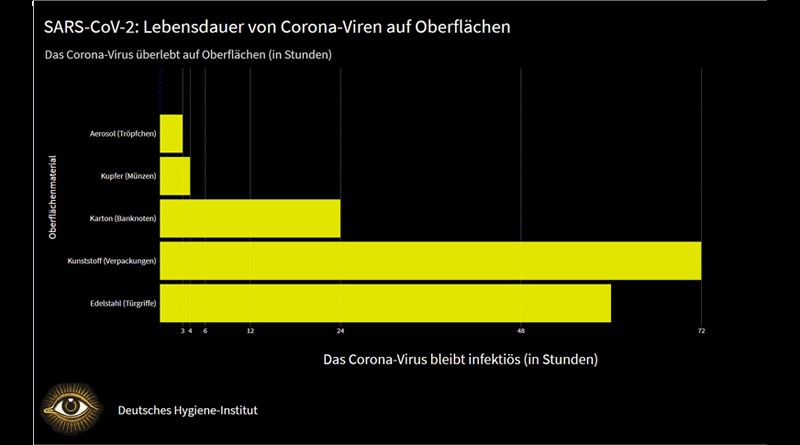“Bei der Ausbreitung des Corona-Virus können, anders als bisher vermutet, Kontakte über Oberflächen, sprich Anhaftung von Virenclustern an Gegenständen, eine große, wenn nicht spielentscheidende Rolle spielen.
winterberg-totallokal : “In bisherigen öffentlichen Verlautbarungen”, so Matthias Dräger, der Sprecher des DHI, “ging man davon aus, daß man eine Ansteckung durch sog. “behüllte Viren”, wie es das Coronavirus ist, z. B. über Geldstücke, “weitgehend vergessen kann”, so der Virologe Christian Drosten, Direktor des Institutes für Virologie. Sie seien, so Drosten, “gegen Eintrocknen extrem empfindlich”.
Diese bisherigen Fehleinschätzungen, auch seitens der WHO zur verharmlosenden Ansteckungsgefahr über Banknoten, bedürfen einer Revision, wenn wir die Coronavirus-Pandemie im Westen in den Griff bekommen wollen. Belegt ist, daß der Corona-Virus, Auslöser der aktuellen Covid-19-Pandemie, viral nachweisbar bleibt für :
- Aerosole (Tröpfchen): bis zu 3 Stunden ;
- auf Kupferoberflächen (also z. B. Münzen) bis zu 4 Stunden ;
- auf Karton/ (also : Papier, Banknoten!): bis zu 24 Stunden
- auf Plastik und Edelstahl : 2 bis 3 Tage.
Zitat Studie vom 17. 3. 2020 :
“SARS-CoV‑2 Stability Similar to Original SARS Virus The virus that causes coronavirus disease 2019 (COVID-19) is stable for several hours to days in aerosols and on surfaces, according to a new study from National Institutes of Health, CDC, UCLA and Princeton University scientists in The New England Journal of Medicine. The scientists found that severe acute respiratory syndrome coronavirus 2 (SARS-CoV‑2) was detectable in aerosols for up to three hours, up to four hours on copper, up to 24 hours on cardboard and up to two to three days on plastic and stainless steel. The results provide key information about the stability of SARS-CoV‑2, which causes COVID-19 disease, and suggests that people may acquire the virus through the air and after touching contaminated objects.” Link : http://ots.de/1r4a1x
Ein Kontakt mit einer kontaminierten Oberfläche von nur 5 Sekunden Dauer überträgt etwa 1/3 der Virencluster. Und : Man faßt sich offensichtlich häufiger mit den Händen ins Gesicht, als man gemeinhin annimmt – in der Regel wohl um die 20 Mal, pro Stunde.
Persistence of coronaviruses on inanimate surfaces and their inactivation with biocidal agents Zitat : “Contamination of frequent touch surfaces in healthcare settings are therefore a potential source of viral transmission. Data on the transmissibility of coronaviruses from contaminated surfaces to hands were not found. However, it could be shown with influenza A virus that a contact of 5 s can transfer 31.6% of the viral load to the hands. […] In an observational study, it was described that students touch their face with their own hands on average 23 times per h, with contact mostly to the skin (56%), followed by mouth (36%), nose (31%) and eyes (31%) [11].” http://ots.de/6Fbh8E
Original-Content von : Deutsches Hygiene-Institut, übermittelt durch news aktuell









